________________
174
THE INDIAN ANTIQUARY
[ SEPTEMBER, 1927
the fame of Raghuvams from the Himalayas to Rama's bridge (a ridge of rocks at the southern extremity of India), that is, throughout the length and breadth of India. As the priests of the temple are the religious preceptors of the kings of Mewâr, who are the donors of large estates to the temple, the word 'Raghuvamsa
must refer to the Guhila family, to which the kings of Mewar belonged. (6) The inscription"3, dated Samvat 1335 (A.D. 1278) of the time of Samarasimha,
while speaking of the Guhilôt king Simha, calls him a Kshatriya. (c) In the inscriptionat on a well built by Mahârâņà Môkala in Samvat 1485 (A.D. 1428)
at Spingi Rishi, six miles from Ekalingaji in Mewâr, Mahârâņa Kshetrasimha,
grandfather of Môkala, is said to be Mandanamani' (jewel) of the Kshatriya family. Now, the question ariser : how is it that Bâpâ and others are called Brâhmanas in some of the inscriptions. The story narrated in Muhnyt Nainsy's khyata explains this deviation. The purport of the story is given below -
After the death of her husband, the mother of Guhilot (Guhila) prepared herself for the pyre to Boconie a Sati in her state of full pregnancy, and as such was prevented by the Brahmanas from doing so. She was soon delivered of a son, whom she handed over to a Brahmana named Vijayaditya, who was praying for a son in the temple of Kôtêsvara Siva. The latter, however, refused to take charge of the child, remarking that, as the infant was the son of a Rajpût, it would, contrary to the duties of a Brâhmaņa, kill men, animals, etc., when it would come of age. On this, the queen assured him, on her honour as a Sari, that the child and its progeny would perform the duties of a Brâhmaņa up to ten generations.
The child was accordingly adopted by the Brâhmana and brought up by him. Thus, according to the legend, the child and his descendants performed the priestly duties for ten generations and were called Någdå (Nagara) Brâhmanas. This son of Vijayaditya belonged to the Solar race and was called Guhilot(Guhila) Sômadata (Sômâditya), after whom came Silâditya and others, 46
It seems, therefore, that some of the old writers (mostly Brâhmans) have based their conception on this or a similar story, and have, either through ignorance of the real fact, or to gratify their vanity by identifying a prince of the blood royal with their own caste, called Bâpâ and others Brahmanas, in opposition to the writings of the Jain scholars.
From what has been said above, we conclude that the Guhila dynasty of Mewâr was established about two centuries before the fall of Valabhipur. The Persian dynasty was also reigning about the same period. But there is no connection between the house of Valabhi and either Mewar or Persia. Also there is no evidence that Nushizad came to India; nor is there any real evidence of the Persian descent27 of the Rands. Col. Tod himself writes in one place that "the prince of Mewar is universally allowed to be the first of the thirty-six royal tribes '; nor has a doubt ever been raised respecting his purity of descent88."
In the case of inscriptions too, we see that, while one or two writers of one age have called Bâpâ and other princes of the family Brâhmaņas, there are many others who have called them Kshatriyas. In fine, neither did the kings of Valabhi owe their origin" to the royal family of Persia; nor did the princes of Mewas owe theirs to that of Valabhi.30
33 Ekalinga-LA-Diw&n' is the common title of the Raņas of Udaipur. 33 fra
1996 ..... raynary from TCT ... ante, vol. XXXIX, p.189. 14 सम्यग्वर्महरं ततः स्वतनबं सुस्थाप्य राज्ये निजे क्षेत्र क्षत्रियवंशमंडनमणि प्रत्यर्थिकालाननं ॥५॥
Unpublished Inscription at Sringt Rishi. 35 Muhnot Nainsy's Khyata, p. I.
26 Tod's Rajasthan, vol. I, p. 276, n. 2. 37 Ibid., p. 278, n. 2.
18 Ibid., p. 247. 39 About 2,000 silver coins bearing the legend 'Srf Guhila' were discovered near Agra (Cunningham's A.S.R., vol. 4. p. 95). From these as well as the Chatsu inscription of BAladitya (Ep. Ind., vol. 12, p. 13), it appears that Guhils and probably his descendants were ruling over the territories extending up to Ags in the north-east,
30 For s previous discussion of the prigin of the Guhilots, we V. Vaidye, History of Mediaeval Hindu India, vol. II (1924), pp. 83-89.-JOINT EDITOR.




